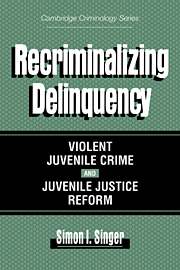Book contents
- Frontmatter
- Contents
- List of Figures and Tables
- Acknowledgments
- Introduction
- 1 Recriminalizing Violent Juvenile Crime
- 2 Taking Stock of Juvenile Justice Reforms
- 3 Recriminalization on the Move and Its Legal Rules
- 4 Contextual and Legal Reasons for Identifying Juveniles as Criminal Offenders
- 5 The Case Processing of Juvenile Offenders: From Arrest to Disposition
- 6 Recriminalization and Organizing for Deterrence
- 7 Convicted Juvenile Offenders in a Maximum Security Institution
- 8 Concluding “Real” Reasons for Recriminalizing Delinquency
- Appendixes
- Notes
- References
- Index
1 - Recriminalizing Violent Juvenile Crime
Published online by Cambridge University Press: 29 September 2009
- Frontmatter
- Contents
- List of Figures and Tables
- Acknowledgments
- Introduction
- 1 Recriminalizing Violent Juvenile Crime
- 2 Taking Stock of Juvenile Justice Reforms
- 3 Recriminalization on the Move and Its Legal Rules
- 4 Contextual and Legal Reasons for Identifying Juveniles as Criminal Offenders
- 5 The Case Processing of Juvenile Offenders: From Arrest to Disposition
- 6 Recriminalization and Organizing for Deterrence
- 7 Convicted Juvenile Offenders in a Maximum Security Institution
- 8 Concluding “Real” Reasons for Recriminalizing Delinquency
- Appendixes
- Notes
- References
- Index
Summary
why recriminalize delinquency? Why did New York State wait until 1978 to respond to violent juvenile crime with legislative waiver? To answer these questions, I start with a description of the incident and the juvenile that triggered waiver legislation in New York. I then shift to the reasons for recriminalization that go beyond one juvenile's violent crimes and the immediate politics of election-year campaigns. Some of the reasons for recriminalization I locate in deep-seated political, as well as organizational, concerns and interests in controlling violent juvenile crime. Those concerns and interests I see as rooted in contemporary efforts to classify and to track a segment of delinquents as violent juvenile offenders in complex systems of juvenile and criminal justice.
The Case of Willie Bosket
In March 1978 Willie Bosket murdered two subway passengers and triggered a crisis in New York's system of juvenile justice. Bosket often roamed the city's subways searching for easy targets to rob, such as drunk and sleepy passengers. Soon after his release from a state facility for delinquents, Bosket was back late at night on the subway line near his home, frequently with his older cousin, Herman Spates. One passenger was in the unfortunate position of having awakened to see Bosket searching his pockets when Bosket pulled the trigger of his .22 caliber pistol and shot him in the head.
- Type
- Chapter
- Information
- Recriminalizing DelinquencyViolent Juvenile Crime and Juvenile Justice Reform, pp. 5 - 23Publisher: Cambridge University PressPrint publication year: 1996
- 1
- Cited by

